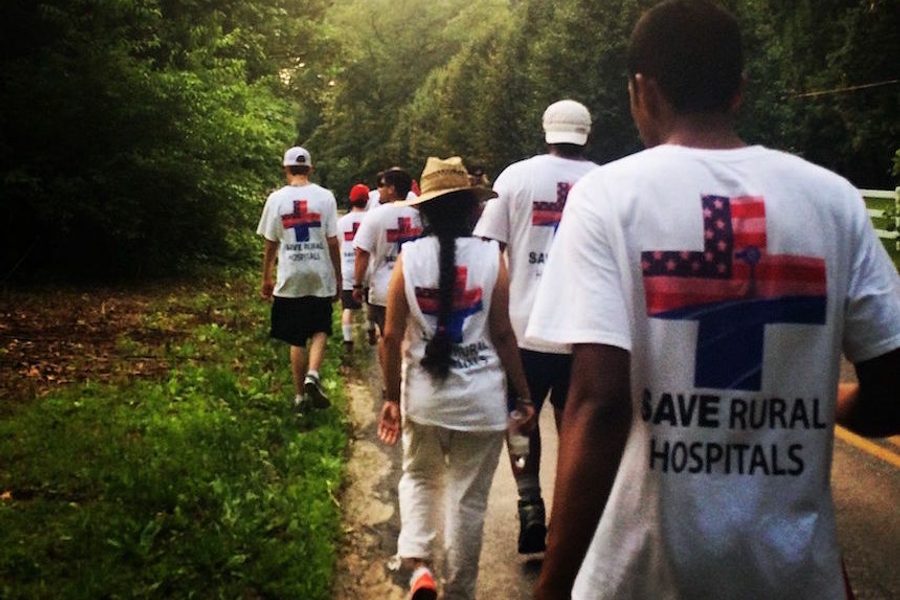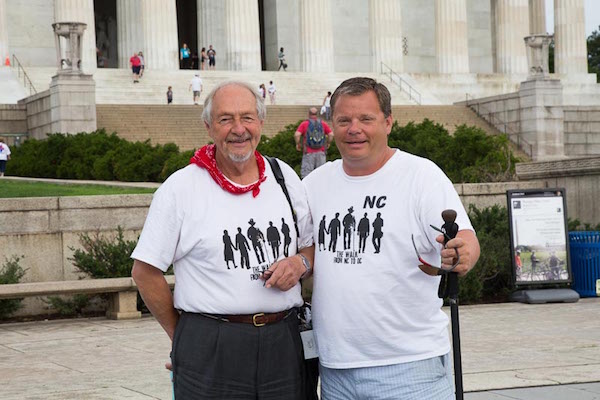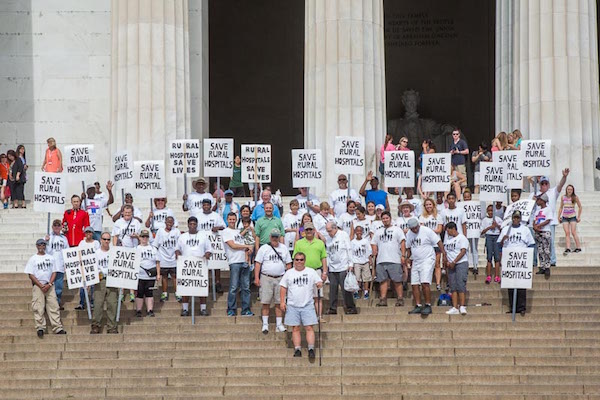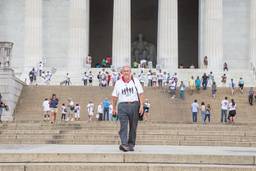When Distance Becomes a Matter of Life and Death: The Walk to Save Rural Hospitals
Shailly Gupta Barnes

In 2014, the Forward Together Moral Movement from North Carolina connected with Adam O’Neal, the Republican mayor of Belhaven, N.C., a small town in the southeast part of the state. Belhaven’s only hospital and emergency room was shut down by Vidant Health last year. After Vidant was been brought in by the town to help manage the hospital, they created a new board under their control. The board decided to close the hospital down, which meant that people in and around Belhaven had to drive an extra 30 miles to the nearest emergency room, to a hospital that Vidant itself owns. Soon after the closure, a woman named Portia Gibbs had a heart attack. She died in a parking lot waiting for a helicopter to come take her to Vidant’s hospital those additional 30 miles away.
O’Neal decided that drastic measures were needed to get the hospital open again, so he planned to walk hundreds of miles from Belhaven to Washington, D.C., in memory of Portia Gibbs, to draw attention to the issue. He was joined by Rev. Dr. William Barber and the Forward Together Moral Movement who supported this life-and-death struggle for health care. After attending the send-off rally, Bob Zellner, a long time rural organizer and civil rights activist, walked with Mayor O’Neal almost the whole way.
This year, O’Neal and Zellner organized The Walk again, this time broadening the fight from just one hospital to the 283 hospitals around the country in danger of being closed. Read more about this year’s walk at their website, and on the Kairos Center blog.
(Note: This is part II of Shailly Gupta Barnes’ interview with Bob Zellner. Click here for Part I of the conversation, “Organizing with Klansmen for Social Justice: Bob Zellner Tells His Story.” The interview has been edited for length and clarity.)
Can you tell us about Mayor Adam O’Neal and the kind of leader he is?
The reason Adam O’Neal is Mayor O’Neal today is because Black mentors took him in hand early on. They had gone to school with him in high school and seen something in his spirit. And he said he wanted to run for mayor, and they said, “You want to be mayor? We can make you mayor.”
One of the first things that Arthur Butch, who took Adam under his wing, says to Adam is, “Have you been to a Black church service?” Adam says, “Well, no.” “Well, you’re going to need to do that.” So the next Sunday, Adam, for the first time in his life, went to a Black Baptist church. And he said, “You know, I’m not much for holding hands or hugging and everything, but this big black deacon met me at the front door with a hand about this big, full of callouses and everything, strong farmworker or maybe works in the pulpwood industry or something.” He said, “That black deacon took my hand in his big old paw and he didn’t let me go for two hours.” He told me, “All day that deacon stuck with me.” So he started to learn about the culture.
What’s Mayor O’Neal’s relationship with Moral Mondays?
Adam now organizes non-violent workshops for he and I and other people to run. We’ve been doing typical classical SNCC nonviolent workshops, doing lunch counters, marches, how do you organize picket lines, how do you have spokespeople, for sometimes 100, 125 people, 50-60 percent of them might be white. A good percentage of Black people, but lots of white people in there.
This to me as an organizer, I mean what kind of opportunity do you ever have for something like that, at the grassroots? I mean these people, some of them are true right-wingers, who are beginning to change but they don’t even realize the extent to which they’re changing just by doing the things they’ve already done.
And what precipitated this action around the Belhaven hospital closures?
Well, Belhaven is in Beaufort County and just east of that is the largest county in North Carolina, which is also the most sparsely populated, and the poorest. So the two counties together are the poorest areas in the state. There’s a Hill-Burton hospital from 1945 there, the first one ever built, a historic hospital. And this Vidant corporation comes in and thinks absolutely nothing of coming in with the intention of closing and destroying the hospital, so that people would have to go 30 more miles to their hospital in Washington, North Carolina, which is also a feeder hospital to their hospital further west in Greenville, so they can make more money. Vidant already has 700 million dollars in reserve — a non-profit organization. And the CEO makes $2 million a year.
The hospital board is headed by Art Keeney who is from Engelhard, North Carolina, which is about 80 miles east of Belhaven. Those people used to have to come 60 or 80 miles to Belhaven, now they have to add another 30 on that, 100 miles or so, or over. Those people are dying down there. And Art Keeney, he’s in charge of economic development for all of eastern North Carolina, his idea of economic development is to close the hospital and destroy a two or three county area.
But the fact is it didn’t have to be closed, not for financial reasons or anything. I mean, for financial reasons, to enrich a tremendously wealthy corporation that already has almost a billion dollars, and because you lost maybe a million dollars in a year when the CEO makes 2 million dollars? Vidant wanted to close the hospital and they kept pumping money into it and charging expenses from other hospitals to Belhaven that it didn’t even incur. The whole salary of the hospital manager — he was only there two days a week — was charged to the hospital. So they loaded up this hospital with all of this stuff and unnecessary people and all kinds of things to show that it’s losing money so they can close the hospital.
So, in Belhaven, Vidant lied about it. They said they had lost a million dollars so they had to close it. Well they intended to close it when they moved there and took over the hospital. And they did that because it was the poorest area, heavily Black, the county is probably 70 percent Black, and a Democratic area basically, with the aberration of being represented by this Republican mayor. Adam O’Neal. And the whole economy of the area depends on this hospital.
Now what if your child gets hit and you need to have them be 5 minutes from emergency care rather than half an hour. And it might mean the difference between that child surviving. A 16-year-old was just run over the other day in Belhaven and since the ambulances were off somewhere else, there’s no emergency room there anymore, they had to wait on the helicopter. And he’s bleeding, he’s badly badly injured. And the helicopter gets there and they said he’s too unstable to go on the helicopter now. So he was maybe 5 minutes from the emergency room at Belhaven, which had been closed, he would’ve been there, he would’ve had blood, he would’ve had doctors and he would’ve had trained people within 5 minutes. And he died the next day because there was an hour and a half before he could get any medical attention. He just bled to death basically, a 16-year-old. It strikes all ages but that is the main worry that people have in Belhaven. People are going to leave who have young children, because it’s a fishing community, it’s a boating community, hunting, farming, all kinds of things. This young 16 year old, if he’d been taken right to the hospital he’d at least of had a chance that he could’ve lived, but once there’s no hospital there it means he dies.
What Adam says is that they underestimated the people in Belhaven, because the people are used to hurricanes, they’re fishing people, they work in the woods, timber, they’re farmers, resilient people. He says they totally disregarded the fact that they were resilient people that were survivors, and that they by-golly were going to fight if they had the right leadership and Adam was there to give the leadership.
So what happened with the Health Care March last year? How did you get involved?
I didn’t go to Belhaven last year and say, “Oh I’m here I’m going to march with you.” I just went with Rev. Barber to get the walk kicked off and we were doing whatever organizing we could to make it a success. I remember it was July, 101 degrees, middle of the day. It was about the dumbest thing you could possibly do. We had a press conference with Rev. Barber and Adam and all of the people wanting to get the hospital back. So I just set off with the others.
And I didn’t plan to go on the whole thing, but after the second day they were down to like 2 people or 3 people, and pretty soon it was just me and Adam. And we’re walking along and it’s me, and Adam, and Adam’s mother, Pam. Three people, way out in the middle of nowhere. We got treed by some dogs one time. We got stopped on this back road and we couldn’t get past the dog. But anyway, Adam he says to me, “Bob, why are you still here?” He was thinking it would just be him and his mother now, walking on the march. And I said, “Well, two marches in my whole life that I know of that were single people marching. And one was William Moore, postman from Baltimore marching in Alabama — he was shot and killed. And James Meredith marching by himself in Mississippi was shot and could’ve been killed.” And I said, “I’m just not going to, no matter what is going on out there, whatever things I have going on, and the fact that my feet are totally destroyed, I’m going to be here with you, you know, for the duration.”

Bob Zellner (left) and Mayor Adam O’Neal at the Rally to Save Rural Hospitals in Washington D.C. (Photo: Kairos Center)
What happened after the Walk last year?
Well, we’ve had some real victories. They’ve got the hospital back now [in Belhaven], but now comes the point of having to crank it up again. They had done a lot of damage to the building. They intended to bulldoze the building but we got a temporary restraining order to stop them from destroying the building. And all the people of Belhaven now are ready to come as witnesses. We’re hoping to get 10 million dollars now from Vidant to open up the hospital in Belhaven.
What’s been Vidant’s response?
They’ve reverted to some of the old tactics, which have backfired on them badly. They’ve said that mayor Adam is a favorite now on Moscow television, that he was on some kind of Russian program and that Al Jazeera has been covering him and the Guardian, the well known radical newspaper in Britain has been, too.
So they’re red-baiting. But red-baiting doesn’t work in the same way that it used to work now. And people say “Well they must be pretty desperate if they’re accusing Adam O’Neal of being a communist.” And they’ve tried to undermine him in the community, but people know him too well. And he’s just that kind of guy, he’s just there and he continues to work with people.
What was the idea behind this year’s walk?
Well, Adam went last year to the national convention of the Association of Rural Hospitals, a thousand hospitals around the country. And he found 283 other hospitals around the country that are closing, about to close, or just closed. And so at that meeting, he had said the idea came to him to have a reprise of the march from Belhaven to D.C., but this time make it national. And he said we want a representative, a walker from each state, because there’s one or two of those hospitals that are closing in every state. Most of them are in the South but many of them are in the North.

The Walk arrives in Washington D.C. on June 15, 2016. (Photo: Kairos Center)
And I mean it’s cold and cynical and people will die. What Adam says is if 283 hospitals close around the country for similar reasons, 2,800 people a year will die unnecessarily, which is like a 9/11 every year, for the next 25-to-30 years. And it costs less to keep these hospitals open, than it will to close them — the long run expenses of closing them will be much greater. The deterioration of the health, the chronic diseases and all these things that people deal with. If you’re not close to a hospital, you’re not going to go get help for your diabetes or other problems until it’s so bad that you have to go to the emergency room at the big hospital.
Calling out the “immortality” of the current system
From June 1 to 15, the Kairos Center joined the Walk From NC to DC, a 283 mile march from Belhaven, N.C., to Washington, D.C., to save 283 rural hospitals that are being threatened or scheduled to close across the country. We met up with Bob, Mayor O’Neal, Rev. Barber, and leaders from Tennessee, Texas, Washington, West Virginia, North Carolina and more who were committing themselves to the right to health care and to save these hospitals.
The Walk was a clear expression of the problems facing our society today, and the kinds of responses that are sorely needed, especially around our right to health care. Indeed, a human right to health care isn’t limited to questions of profitability or even affordability. Instead, it asks whether we are meeting the health care needs of our families, children, veterans, and broader communities and if not, how we can and must do so. In this way, the Walk from NC to DC was an expression of what a New Poor People’s Campaign for Today looks like — bringing people together across race, age, and geography to raise the question of how we meet our most basic human needs in a time of plenty.
The power of this moment is in the people who are calling out the immorality of the current system and demanding that we seize the opportunities made possible today. And while we walked for rural hospitals, we all know that this is only the beginning.
This interview was originally posted on the Kairos Center website and is reposted on Rural America In These Times with permission. Kairos works to strengthen and expand transformative movements for social change that can draw on the power of religions and human rights.





